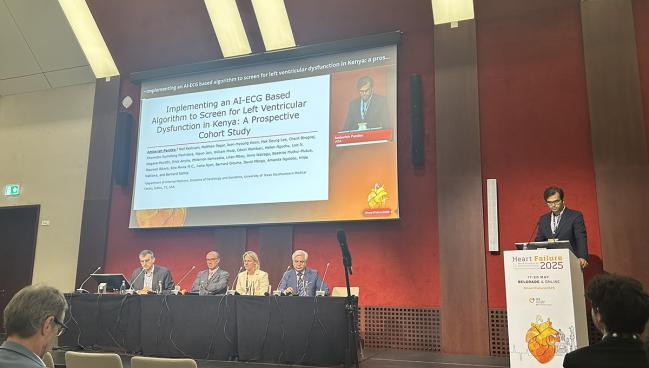AI-ECG Helps Find Subclinical Heart Failure in Kenya
The results have implications not only for resource-limited parts of the world, but also for wealthier countries, one expert says.

BELGRADE, Serbia—An artificial intelligence algorithm for interpreting electrocardiograms (AI-ECG) can identify individuals who have subclinical heart failure (HF) when echocardiography isn’t widely available, a study conducted in Kenya suggests.
The AI-ECG model had “robust diagnostic performance” for detecting left ventricular systolic dysfunction (LVEF < 40%) with high sensitivity, specificity, and negative predictive value, Ambarish Pandey, MD (UT Southwestern Medical Center, Dallas, TX), reported here at the European Society of Cardiology’s Heart Failure 2025 congress.
A positive screen by the AI algorithm was associated with several markers of adverse cardiac remodeling, including LV hypertrophy and diastolic dysfunction, he said.
“These findings support the potential for [an] AI-ECG-based algorithm for screening of LV systolic dysfunction in resource-limited settings,” Pandey concluded.
But Christian Mueller, MD (Cardiovascular Research Institute Basel, Switzerland), who was not involved in the research, indicated that there may be broader implications. “I think it would have great utility also in resource-rich countries because the detection of heart failure, or specifically this phenotype, is still an unmet need in all of our countries,” he said.
Overcoming Limited Echo Access
Though the burden of HF is rising around the world, it’s a particular problem in sub-Saharan Africa, where patients present at younger ages, have a greater risk of adverse outcomes, and have less access to evidence-based treatments compared with high-income areas, Pandey said. That’s on a background, he noted, of increasing prevalence of cardiovascular risk factors.
“Early detection of left ventricular systolic dysfunction could enable timely intervention and prevent progression to symptomatic, overt heart failure,” Pandey said. “However, the gold-standard diagnostic tool for ejection fraction, echocardiography, is a limited resource in low-middle income countries, and there is a need for strategies that can allow us to better prioritize who needs to get an echo for screening for LV dysfunction.”
Recent advances have led to the development of AI-ECG algorithms that can detect subtle patterns associated with LV dysfunction. One of them, called AiTiALVSD, was shown in a single-center prospective study to have good discrimination to detect an LVEF below 40%, Pandey highlighted.
But, he added, “the broader assessment of its performance, particularly to detect subclinical heart failure and LV systolic dysfunction in resource-limited environments such as sub-Saharan Africa, remains undetermined, and accordingly, we do not know if such a strategy can be scaled and implemented for LV systolic dysfunction screening in the broader community.”
To explore those questions, Pandey and his colleagues conducted a prospective study in eight healthcare facilities in Kenya. They recruited 5,992 adults who were receiving routine clinical care, all of whom received a standard 12-lead ECG, with the AiTiALVSD algorithm applied to the results in a blinded fashion. The investigators compared the performance of AI-ECG for detecting low LVEF with echocardiography in a subset of 1,444 patients.
Patients were stratified into high and low risk, with high risk defined by the presence of at least one of the following: prior history of CAD, presence of pathologic Q waves on ECG, or Framingham risk score (FRS) above 10%. Low risk was defined as having an FRS below 10% without any high-risk criteria.
The primary outcome of the study was the prevalence of LV systolic dysfunction according to AI-ECG, which was 18.3% overall. That figure was higher in patients with a high FRS (23% vs 10% with low FRS) and those with existing CVD (32% vs 15% without CVD).
The detection of heart failure, or specifically this phenotype, is still an unmet need in all of our countries. Christian Mueller
In the subset of patients who received an echo, 14.1% had confirmed LVEF below 40%, again with higher rates in patients with a high FRS or existing CVD.
The echo and AI-ECG results were concordant in 82% of patients. Sensitivity of the AI algorithm was 96% and specificity was 79%, with a negative predictive value of 0.991 and a positive predictive value of 0.432, “highlighting the robust performance” of the tool, Pandey said. These values were similar in both high- and low-risk patients.
Factors associated with a positive AI-ECG screen for LV systolic dysfunction, after adjustment for age, sex, and FRS score, included the presence of clinical HF symptoms (OR 8.25), diastolic dysfunction (OR 9.37), and LV hypertrophy (OR 7.38).
The study had a “very good methodology,” Mueller commented, adding that “it addresses a very promising tool, one that has been evolving over the last few years. Several algorithms are available and, for sure, these kinds of prospective studies are very helpful to highlight their clinical performance and also their utility for different indications.”
Todd Neale is the Associate News Editor for TCTMD and a Senior Medical Journalist. He got his start in journalism at …
Read Full BioSources
Pandey A. Implementing an AI-ECG based algorithm to screen for left ventricular dysfunction in Kenya: a prospective cohort study. Presented at: ESC Heart Failure 2025. May 17, 2025. Belgrade, Serbia.
Disclosures
- The study was supported by grants from AstraZeneca and in-kind support from Tricog Health and algorithm support from Medical AI.
- Pandey reports receiving research support from the American Heart Association, Anumana, AstraZeneca, the National Institutes of Health, Roche Diagnostics, scPharma, SQ Innovation, and Ultromics; and consulting for Northwestern University, Tricog Health, Lilly USA, Rivus, Cytokinetics, Roche Diagnostics, Sarfez Therapeutics, Edwards Lifesciences, Merck, Bayer, Anumana, Novo Nordisk, Alleviant, Pfizer, Abbott, iRhythm, Axon Therapies, Kilele Health, Acorai, Ultromics, Kardigan, Novartis, Idorsia Pharma, Science 37, and Palomarin.





Comments